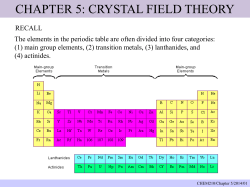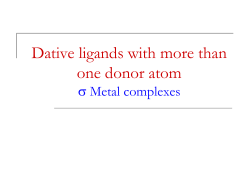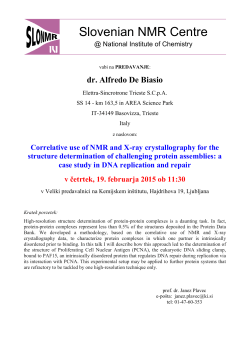
(2-hydroxyphenylimino) methyl-6
Available online www.jocpr.com Journal of Chemical and Pharmaceutical Research, 2015, 7(2): 917-923 Research Article ISSN : 0975-7384 CODEN(USA) : JCPRC5 Synthesis, spectral and thermal properties of complexes derived from 2-(2-hydroxyphenylimino) methyl-6-methoxyphenol Bushra K. Alsalami1*, Rehab G. Abood2, Hanadi M. Jarallah2 and Zuhair A. Abdulnabi3 1 2 University of Basrah, College of Science, Chemistry Department, Basrah, Iraq University of Basrah, College of Education for Pure Sciences, Chemistry Department, Basrah, Iraq 3 University of Basrah, Center of Marine Science, Basrah, Iraq _____________________________________________________________________________________________ ABSTRACT New metal complexes derived from schiff base ligand resulted from condensation of o. Vanillin and o. amino phenol. The ligand characterize by 1HNMR, 13C NMR mass and IR. The ligand acts as tridentate coordinating with Cu(II), Co(II) and Cd(II) Via azomethine nitrogen and two enolic hydroxyl oxygen after displacement of hydrogen. The thermodynamic parameters ∆E, ∆H, ∆S and ∆G have been calculated from Tg data by Coat- Redfern method. Keywords: Schiff base, Coat -Redfern. _____________________________________________________________________________________________ INTRODUCTION The condensation of primary amines with aldehydes and ketones give imines (Schiff base) which contain an azomethine group .Schiff base are capable of forming coordinate bonds with many of metal ions through azomethine group phenolic group and others [1,2]. Schiff base and their metal complexes have exhibited biological activity, catalytic activity , anticorrosion inhibitor [3,4] .etc. There are several report on the thermal stability of Schiff base complexes. most complexes show high stability compared with corresponding ligand . EXPERIMENTAL SECTION 2.1 : Material : o-aminophenol ,metal acetate salts from Fluka ,o-vanillin from Himedia , all solvents used were of analytical grade and were used without further purification . 2.2 :Measurements : IR spectra were measured using KBr discs on a SHIMIDZU-84005. El-mass spectrum of the ligand was recorded on Agilient. 1 HNMR and 13C NMR were recorded on a Bruker (400 MHz for HNMR and 100 MHz for DMSO-d6 as a solvent. 13 C NMR ) using Thermal analyses measurements (Tg and DTG) were recorded on a Rheometric Scientific lnc.1998. nitrogen flow rate 10 cm3/min and heating rate 10 c/min. The physical properties of the ligand and metal complexes are given in Table 1. 917 Bushra K. Alsalami et al J. Chem. Pharm. Res., 2015, 7(2): 917-923 ______________________________________________________________________________ Table 1: physical properties of compounds compounds R RCu RCo RCd Physical state Yellow Crystal Green powder Brown powder Brown powder m.p oC 192- 193 > 300 > 300 > 300 Yield % 64 77 85 80 2.3 :Preparation : 2.3.1 : Preparation of the ligand : A solution of 10 mmole of o-aminophenol in 25 ml ethanol was added to 10 mmole of o-vanillin in 25 ml ethanol, the resulting solution was refluxed for 3hrs .The solid Orange , product which obtain was filleted off washed with ethanol and dried in air .Yield 74 % .M.p 192-193 oC . 2.3.2 : synthesis of metal complexes : Metal complexes were synthesized by adding the hot solution of the ligand (2mmole ) in ethanol to a hot solution of metal acetate (2 mmole ).The resulting mixture was then refluxed for 2 hours .The complexes which separated was filtered hot and washed with ethanol and then with diethyl ether and dried in air. IR Spectra : The ligand showed a strong band at 1633.7 cm-1 attributed to stretching vibration of azomethine group ,this band shifted to lower wave number in Co II ,Cu II and Cd II complexes by 13، 30 and 38 cm-1 respectively which indicated the coordination of azomethine nitrogen on complexation [2,4]. The ligand show a broad band at ν (3550.4) cm-1 characteristic of stretching vibration of OH group , this band disappear in all complex spectra (Fig 1,2) suggests the linkage of phenolic oxygen with metals after deprotination also a strong band at ν 1226.73 cm-1 [5,6] in the IR spectrum of the ligand attributed to ν C-O (phenolic ) gets shifted to a lower wave number in the complexes by 15- 48 cm-1 and this is indicative of bonding through phenolic oxygen [7]. Figure 1: IR Spectrum of R 918 Bushra K. Alsalami et al J. Chem. Pharm. Res., 2015, 7(2): 917-923 ______________________________________________________________________________ Figure 2: IR Spectrum of RCu 1 HNMR : HNMR spectrum of the ligand show three singlet signal one of them at δ 8.94 ppm (1H) attributed to azomethine (CH=N-) proton [9,10] and the other signal at δ 9.78 and 14.1 ppm due two phenolic protons .the multiple signal in the rang δ 6.84 – 7.39 ppm attributed to aromatic protons [7] also a singlet signal at δ 3.84 ppm due to methoxy protons [3,4] (Fig 3). 1 The 1HNMR spectrum in DMSO-d6 of diamagnetic complex (Cd complex) (Fig 4) , spectrum shows a singlet signal at 8.4 ppm assigned to the proton of the (-HC=N-) which shifted to higher field ,this is probably due to the involvement of C=N to form a M← N linkage [6,8] .The totally absente of the two singlet signals in the spectrum of the complex confirms that the two phenolic groups involvement in complex formation. Figure 3: 1H NMR Spectrum of R 919 Bushra K. Alsalami et al J. Chem. Pharm. Res., 2015, 7(2): 917-923 ______________________________________________________________________________ Figure 4: 1H NMR Spectrum of RCd 13 CNMR : CNMR spectral data of the free ligand was shown in (Fig 5 ) . The peak at δ 161.52 ppm is assigned to azomethine carbon [6]. The two phenol carbons appear at 150.95 and 151.76, The peak at 148.12 ppm attributed to C-N carbon . The aromatic carbons appear at 115-134 ppm, The peak at 55.79 is assigned to the carbon of methoxy group.[4] 13 Figure 5: 13C NMR Spectrum of R El-mass : The mass spectrum of the ligand (Fig 6 ) shows the exact molecular ion at m/z =243.3 with relative abundance 100% (base peak ). This peak undergoes fragmentation to produce stable peak at 225.3 by losing of water molecule [4] . The peak at m/z=196.2 corresponds to the ion [C13H10ON] +. Thermal analysis : The thermal investigations were carried out from room temperature to 800 oC with a heating rate of 10 oC/min in nitrogen atmosphere. The thermal degradation of RCo complex proceeds in three different stages ( Fig 7 ) . the first decomposition process takes place between 80 and 140 oC with 2.13% weight loss (theoretical 2.47%) (DTG max 110 oC) which assigned to the loss of half molecule of water . The second step lies in the temperature rang 150 − 220oC (DTG max 170oC) with mass loss 14.65% (theoretical 14.83% ) corresponds to the loss of 3H2O coordinated [11] . The third step lies in the temperature range 230-600 oC (DTG 370oC) corresponds to the loss of C14H11NO2 , found 60.53% (cal. 61.81%) [12]. 920 Bushra K. Alsalami et al J. Chem. Pharm. Res., 2015, 7(2): 917-923 ______________________________________________________________________________ In Tg curve of RCu no mass loss in the range 25 – 150 oC which indicate the absences of any lattice water molecule. the first step of loss in the range 150 - 210 oC with mass loss 5.41% (theoretical 5.59% ) indicate the presence of one coordinated water molecule . The second step take place at 380 – 405 ℃ range of temperature and in fast rate to give the final residue 28.45% which may be attributed to CuO polluted with C atoms [13] (theoretical 25.98 ℃). Figure 6: Mass Spectrum of R Wt loss % For RCd complex the first mass loss in the range 40 – 135 ℃ found 14.41% (theoretical 14.69%) which prove the presence of four lattice water molecules. The second step of decomposition in the rang 150 – 205 ℃ found 11.1% (theoretical 11.22%) indicate the presence of three coordinated water molecules the final product 26.5% (theoretical 26.61%) with agreement with CdO. Temp ℃ Fig.7: TG and DTG Curve of complex RCo 921 Bushra K. Alsalami et al J. Chem. Pharm. Res., 2015, 7(2): 917-923 ______________________________________________________________________________ Based on the thermal and spectral data (IR,HNMR) ,the following structure are proposed for complexes. The thermodynamic parameters (∆E , ∆H , ∆G and ∆S) were calculated by the Coat – Redfern method (equation 1) [14 -16] and the result were collected in (Table 2) The positive ∆H show endothermic decomposition of the complexes . The negative value of ∆s indicate that the complexes has more ordered structure . The positive values of ∆G indicate the non-spontaneous character of the all decomposition steps . . ⋯⋯⋯ (1) Table 2 : Thermal decomposition data and Kinetic parameter calculated from Coat - Redfern method of the complexes Comp. RCo RCu RCd stage TG rang DTG max I II III I II I II III 80-140 150-220 230-600 150-210 380-405 40-135 150-205 285-578 110 170 370 195 400 95 185 375 Mass loss% found Calcu. 2.13 2.47 14.65 14.83 60.53 61.81 5.41 5.59 67.35 69.87 14.41 14.69 11.1 11.22 46.5 47.60 Assign-ment A (S-1) E ∆H ∆S ∆G 1\2 H2O 3 H2O C14H11NO2 H2O C14H11NO2 4 H2O 3 H2O C14H11NO2 3.6 ×109 3.1 ×1010 3.07×109 1.3 ×104 1.9 ×105 2.75×104 1.06×104 4.03×106 60.82 99.54 39.90 89.7 465.2 50.1 98.2 154.1 57.64 95.86 34.55 -85.2 -459.53 -47.31 -93.61 -150.3 -0.102 -0.047 -0.222 0.151 -0.423 0.113 0.088 0.104 96.76 116.77 177.8 120.2 170.1 90.2 136.7 175.9 REFERENCES [1]M.M.Ali, M.Jesmin ,S.M.Salam. J.A.Khanam , M.F.lslam and M.N.lslam : Journal of Scientific Res. (2009), (3), 641-646. [2]R. Jayarajan, G. Vasuki and P. S. Rao: Organic Chemistry lnternational Article LD 648589, doi (2010), 10.1155/ / 648589. [3] A.Z.El-Sonbati and A.A.El.Bindary :Polish J.chem. (2000),74 , 621-630. [4] G.G.Mohamed, M.M.Omer and A.M.Hindy: Turk.j.chem. (2006) ,30 , 361-382. [5] A.A.Maihub ,M.M-El-ajaily and N.A.El-hassy :lnt. J. of chem. Tech Res. (2012) ,4 (2) , 631-633. [6] A.Sharma , T.Mehta and M.K.Shah :Der chemical Sinica , (2013) ,4 (1) , 141-146. [7] Sh. A. Sallam and M.I.Axad :J. of the Korean chemical society.(2003) ,47(3) , 199-205. [8] L.A. Saghatforoush , B. Shabani ,R. Khalilne Zhad ,M.hasanzadeh , G.karmanezhad and S. Ghammany :Asian J. of chemistry, (2009) , 21( 8 ) , 6317- 6325. [9] R. M. Issa, A. M. Khedr and H.Rizk : J. Chin. Chem. Soc. (2008), 55(4) , 875 – 884. [10] O. N. Kadkin and Y. G. Galyametdinov : Electronic - Liquid Crystal Communi-cation, (2007) , 22, 1 − 14. [11] M. M. Mashaly, Z. H. Abd – Elwahab and A. A. Faheim : J. Chin. Chem. Soc. (2004) , 51(5A) , 901 − 915. [12] A. P. Mishra and P. Gupta : J. Chem. Pharm. Res. (2011) , 3(2) , 150 − 161. 922 Bushra K. Alsalami et al J. Chem. Pharm. Res., 2015, 7(2): 917-923 ______________________________________________________________________________ [13] A. A. M. Ali, A. H. Osman, M. Abd El –Mottaleb and G. A. H. Gouda : J. Chil. Chem. Soc. (2009) , 54 (4) , 349 – 353 . [14] S. A. Abdl El – Latif, H. B. Hassib and Y. M. Issa : Spectrochimica Acta Part( 2007 ) , A 67, 950 – 957. [15] H. F. Abdl El –Halim, M. M. Omar, G. G. Mohamed and M. Abd El – Ela Sayed: European Journal of Chemistry, (2011) , 2( 2), 178 – 188 . [16] G. G. Mohamed, M. M. Omar and A. M. Hindy : Turk J Chem , ( 2006 ) , 30 , 361 – 382 . 923
© Copyright 2025





















